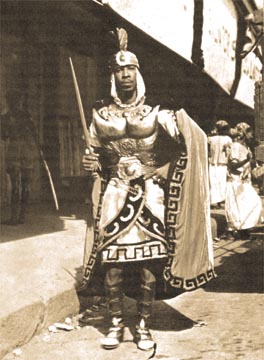|
|
 Ken Morris 1955, in one of his copper breastplates
Ken Morris 1955, in one of his copper breastplates
Pages: 01 | 02 | 03 | 04 | 05 | 06 | 07 | 08 | 09 | 10 | 11 | 12 | 13 | 14 | 15
Everything was handmade back then
Staff Article
Interview Recorded: April 25, 2005
Posted: May 15, 2005
Everything was handmade back then; even the tools that were used to put patterns in the copper, the breastplates and the helmets. A band in those days if you had sixty or seventy people was considered as a big band. The impact that those little bands created was huge. Just imagine seeing the shining metal in the sun, and the plumes, whether it was Romans or Greeks you were playing. That is something we all long to see again. That was where it all started. But the thing about that is, my father and his friends used to go to the movies to see (movies) like "Quo Vadis" and watch all the old movies with a lot of Romans and Greeks, and they would copy those productions as best as they could. Every year they would change, but it was always a mas' that was produced with copper, aluminum and metal. These materials were used on the helmet, the arms, the legs and the breastplate. The breastplate of course, depending on where the costume came from, will take different shapes. The amour was really protection to fight against in war, so it was to protect your body. A lot of them like the knights had visors, and the visors were made to operate; it wasn't just a show, they were actually functional. You could have raised your helmets and put them back down. They were that meticulous back then in the fifties.
Bands like 'Back to Africa' sort of broke the ice of the metal because they got Africans, colours and so on. Designs would compete against each other whether it was metal or it was cloth. Metal and copper became expensive. I think the copper was imported for purposes in the oilfields. My father and these guys in those days found a way to source that material from the oilfields suppliers. They had recognized that it was a prestige thing and the price kept going up until they priced the mas' out of existence. There are only two places in Trinidad right now that sell copper sheeting: William H. Scott and Trinidad and Tobago Oilfield Supplies, in Marabella. Copper is sold in different size sheeting, and a fourteen-inch by forty-eight inch sheet is about two hundred dollars now. When you have to use a few sheets to make a costume now, you have to start with about eight hundred dollars. Most of the money is going to come with labour, because somebody is going to have to take the time to shape it. It has been priced out of range.
Most of the traditional mas' is competitive now. I am a member of the NCBA, and we have now categorized mas' that is traditional, and mas' that is non-traditional; obviously because of the bikini and bead everybody sees all the time. If you open the papers today you cannot tell the bands apart, you will have to read it. With our band for instance, which is a small sailor band in Belmont call The B.O.S.S. (Belmont Original Stylish Sailors), we have more or less kept the tradition of Fancy Sailor and maintained that old time style. Even some of my costumes and headpieces are still done in papier mâché, which is something you do not see again; even Geraldo Vieira has graduated to plastic. When I want to do something, I do not have any plastic industry that I can go to for supplies, so I still go back to making molds, even though the drying time is a little bit tricky. I make my own ovens by using a drum and putting a ring burner at the bottom to get my stuff out in time; otherwise Carnival will pass. One papier mâché mold will take four to five days in the sun to dry; you do not have that time.
Continue...
Pages: 01 | 02 | 03 | 04 | 05 | 06 | 07 | 08 | 09 | 10 | 11 | 12 | 13 | 14 | 15
|

|
